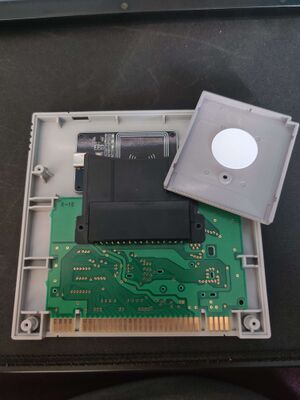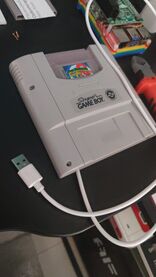Super TapTo Boy
Super TapTo Boy is a custom case project created by Phoenix that utilizes an SNES shell with an SBC inside, designed to work with a Super Game Boy for reading games. The Super Game Boy contains a PN532 NFC reader connected to an SBC (either a DE-10 Nano or a Raspberry Pi), which is housed inside the SNES shell. These components are connected internally via a wired USB connection.
The games' paths are written onto an NFC chip or tag using the TapTo Life app. This chip is then placed inside a Game Boy cartridge, which is read by the NFC reader located within the Super Game Boy. This process initiates the game on the desired hardware. More information on using the TapTo Life app to write games to NFC chips can be found here.

Introduction

This project started it's life after contemplating on how best to use physical media together with software or hardware emulation. Since the MiSTer Project and the multitude of Linux-based Emulation operating systems have no physical media for games, a lot of people resort to modding and using their own classic consoles for the most nostalgic looking and feeling experience. Currently software and hardware emulation have come a long way and are in some cases (almost) interchangeable with original hardware accuracy-wise. The absence of physical media keeps people from viewing this route as a 'complete' and authentic experience.
The TapTo project introduces a new way for people to fill this gap with physical NFC cards. Super TapTo Boy tries to improve upon this concept with physical cartridges to replicate the feeling of inserting games and having a classic console to look at while keeping the cost relatively low compared to modding original hardware for the same performance.
The build
In this section, I will discuss the building process of the Super TapTo Boy. As a disclaimer, this process requires some soldering skills and involves cutting or removing parts of your existing hardware. I would rank this process as intermediate. If you enjoy tinkering, read on. Otherwise, consider seeking help from others before attempting any irreversible modifications.
With that out of the way, below is a list of the requirements for this build. Try to acquire as many of these items as possible before you begin.
First, you will need either a European Super Nintendo or a Japanese Super Famicom. The American Super Nintendo might work as well, but due to its different shape and size, and since I do not own one, I cannot guarantee that all steps will work perfectly, so your experience may vary.
Second, you will need a Super Game Boy and some Game Boy cartridges. These can be purchased online or you can use your own cartridges that you want to put an NFC chip into (more on that later).
Preferably, you will also need a 3D printer to print some parts for the build, although these are cosmetic and not mandatory.
Additionally, you will need some cables and other items. Keep in mind that we have limited space in the case, so the smaller or shorter the items are, the better:
Mandatory:
- A 90 degrees USB-C to USB-A cable
- Some shrink cables
- DuPont cables
- Round NFC tags (NTAG 215)
- A PN532 NFC reader with USB-C (black one)
- General tools like a plier and screwdrivers (including 3.8 mm and 4.5 mm Gamebit screwdrivers for the Super Nintendo, Super Game Boy, and Game Boy cartridges)
- Double sided tape (I used 3M heavy duty tape)
Optional:
- A small USB hub for inside the case to hook your devices to. Don't make this too big or it won't fit. Also don't hook up too many (power hungry) devices to it as all of it needs to be powered by the board.
- Female USB-A and C ports
- A Bluetooth dongle
- A Wi-Fi dongle
- A Pico Pi for the front controller ports
- Soldering iron and wire
Readying the Super Gameboy
Steps:
- Open the Super Game Boy: Open up the Super Game Boy and remove everything, including the PCB board. Take the back of the shell and cut some of the support bars to make room for the NFC reader. Cut everything in the green area.
- Prepare the Shell: After you're done, it should look like this. Ensure the cut areas are flat and won't scratch the back of your NFC reader. You can sand these off, but be careful not to overdo it.
- Position the NFC Reader: Position the NFC reader to the back of the Super Game Boy case as shown. Ensure the NFC reader is positioned so that the USB-C cable can still be plugged into it. I made the mistake of placing the NFC reader too flat in the center, which caused my USB-C cable not to fit anymore. Test the position with the cable and the NFC reader to get it just right before applying the double-sided tape.
- Adhere the NFC Reader: After finding a good position where both fit, adhere the reader to the back. Note that having the NFC reader on the shell doesn't guarantee it will read the NFC tags in your cartridges because the cartridge slot remains in a fixed position. You can adjust by applying the tags slightly more to the right in your Game Boy cartridges to compensate for any misalignment.
- Align the NFC Tag: Depending on the position of your NFC reader, you may need to adjust the position of the NFC tag in your Game Boy cartridges to align as much as possible. This will give you the highest chance of a successful scan and game read. It doesn't matter if the NFC reader is off-center, as long as the NFC tag is in a similar position.
- Cut an Opening for the USB Cable: The final step for the Super Game Boy is to cut a small opening for the USB cable to fit through. I initially tried routing it through the button, but that didn't work well as the cartridge slot of the Super Nintendo didn't accommodate it. If you cut at a low position as shown in the picture on the right, this cut won't be visible once the Super Game Boy is inserted into the case. I deemed this a necessary modification for the project.
- Fit the Super Game Boy into the SNES Case: This is where the USB cable should pass through to get inside the Super Nintendo case. It requires some wiggling and fidgeting to get it in, so ensure it fits without forcing it too much.
-
Step 1
-
Step 2
-
Step 3
-
Step 4
-
Step 5
-
Step 6
-
Step 7

At this point you have reached a checkpoint and should you wish, could even use the Super TapTo Boy like this as a standalone reader on your MiSTer via USB. The only thing left to do after this is to make custom labels for your games (or just use the original ones on your cartridge) and play them.

I invite everyone to come up with new and clever ways to display the cases and games. Perhaps designing and 3D-printing and stand that the Super TapTo Boy can stand on or slot into. The sky is the limit!
Special thanks to: Wizzo, BedroomNinja and Anime0t4ku for making this possible.
Readying the Super Nintendo
Coming soon...

Written by Phoenix






